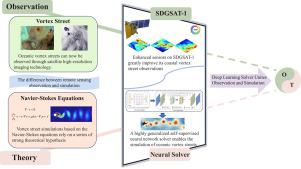深度学习求解器将 SDGSAT-1 观测数据和纳维-斯托克斯理论结合起来,研究海洋涡街
IF 11.1
1区 地球科学
Q1 ENVIRONMENTAL SCIENCES
引用次数: 0
摘要
世界上第一颗可持续发展目标科学卫星(SDGSAT-1)提供了有关近海小尺度海洋现象的宝贵数据,其中包括卡尔曼涡街现象。尽管海洋涡街现象的模拟不仅对理解流体动力学中涡旋的形成机制至关重要,而且对理解其对周围环境的影响也至关重要,但传统的模拟依赖于纳维-斯托克斯方程的强大理论假设。在此,我们提出了一种具有高泛化能力的自监督神经网络来实现纳维-斯托克斯方程,模拟现实的海洋涡街。具体来说,首先利用物理信息卷积神经网络确定相应的压力场和速度场,以较低的计算成本实现了对海洋涡街的精确模拟;然后,将 SDGSAT-1 图像中的观测岛屿作为障碍物嵌入其中,同时同步纳入包括风和地形在内的海洋背景场,使模拟结果较传统方法更加逼真;最后,计算海洋涡街的形态参数并进行相关分析,加深对小尺度涡街现象的理解。此外,实验结果表明,我们提出的方法可以获得良好的时间效率。通过这种将观测与理论相结合的偏微分方程深度学习求解框架,将有可能加快对海洋现象的认知过程。本文章由计算机程序翻译,如有差异,请以英文原文为准。

Deep learning solver unites SDGSAT-1 observations and Navier–Stokes theory for oceanic vortex streets
The world’s first scientific satellite for sustainable development goals (SDGSAT-1) provides valuable data about offshore small-scale ocean phenomena, including the Kármán vortex street phenomenon. Although the simulation of the oceanic vortex street phenomenon is crucial for understanding not only the mechanisms of vortex formation in fluid dynamics but also their impact on the surrounding environment, the traditional simulation relies on the strong theoretical hypothesis of Navier–Stokes equations. Here, we propose a self-supervised neural network with high generalization ability to implement Navier–Stokes equations, simulating realistic oceanic vortex streets. Specifically, the physical informed convolutional neural network is first employed to determine the corresponding pressure and velocity fields, achieving accurate simulation of oceanic vortex streets with lower computational cost; Then, the observational islands in SDGSAT-1 imagery are embedded as obstacles, meanwhile, the marine background field including wind and terrain is synchronously incorporated to achieve more realistic simulation results compared with traditional methods; Finally, the morphological parameters of oceanic vortex streets are calculated and associated analysis are carried out to deepen our understanding of small scale vortex street phenomena. In addition, the experimental results demonstrated our proposed method can obtain promising time efficiency. With this partial differential equation deep learning solver framework combining observation and theory, there will be potential to expedite the cognitive process of oceanic phenomena.
求助全文
通过发布文献求助,成功后即可免费获取论文全文。
去求助
来源期刊

Remote Sensing of Environment
环境科学-成像科学与照相技术
CiteScore
25.10
自引率
8.90%
发文量
455
审稿时长
53 days
期刊介绍:
Remote Sensing of Environment (RSE) serves the Earth observation community by disseminating results on the theory, science, applications, and technology that contribute to advancing the field of remote sensing. With a thoroughly interdisciplinary approach, RSE encompasses terrestrial, oceanic, and atmospheric sensing.
The journal emphasizes biophysical and quantitative approaches to remote sensing at local to global scales, covering a diverse range of applications and techniques.
RSE serves as a vital platform for the exchange of knowledge and advancements in the dynamic field of remote sensing.
 求助内容:
求助内容: 应助结果提醒方式:
应助结果提醒方式:


